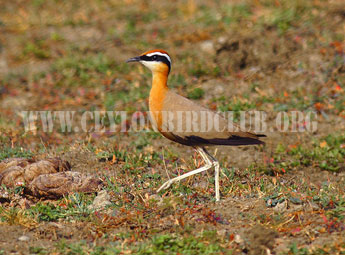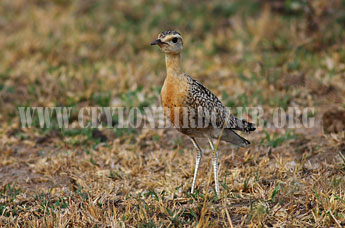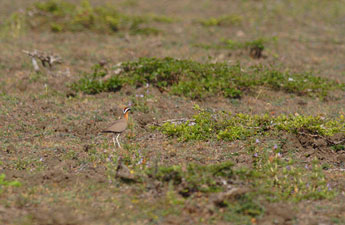


THE INDIAN COURSER Cursorius coromandelicus IN SRI LANKA
Pathmanath Samaraweera CBCN November 2011 pp 2014-2020
 The Indian Courser had been in my ‘most wanted’ list almost from the time I started bird watching. I am certain the same is true for many Sri Lankan bird watchers.
The Indian Courser had been in my ‘most wanted’ list almost from the time I started bird watching. I am certain the same is true for many Sri Lankan bird watchers.
The bird’s striking good looks, extreme wariness, restricted range and scarcity of numbers in Sri Lanka have contributed greatly to this.
The Indian Courser occurs only in the arid belt of plains, mostly coastal, extending from the Jaffna peninsula to the south of Mannar. The range does not extend more than a few kilometres inland from the coast.
Legge (1880) gives its range as being from the Jaffna Peninsula southwards to Pomparippu, which is now within the Wilpattu National Park. He, however, states that he had never seen it in the Jaffna peninsula and that the greatest concentration of the bird was around Arippu. Henry (1955) gives the bird’s southernmost range as Marichchukkaddi, just north of Wilpattu. He, too, writes that during a two-year stay in Jaffna he never saw it. Phillips (1972) gives the range as extending to Puttalam.
Both Legge and Phillips considered it to be a moderately plentiful resident, though in small numbers, within its range. Phillips found it breeding in the Mannar area.
In June1966 T S U de Zylva found three nests in the Talladi area in Mannar where the Talladi army camp is situated now.
Since, records of the bird have been few and far between. In a letter to Loris (June 1978), C S de Saram and Ranjit Perera report a bird being seen on the Pooneryn road north of Mannar in January 1978.
However the late C B Bavinck who was, for many years during the war, the only observer to send reports to the Ceylon Bird Club from the Jaffna peninsula, regularly reported the bird during the nineties. Subsequently the sightings of the Indian Courser from Jaffna became less and less and he last reported the species from the island of Delft, during the migratory season. From 2001 all reports ceased.
Though the Indian Courser is widely distributed in India, in Sri Lanka the bird is so scarcely reported that the IUCN (2007) Sri Lanka Red Data List categorizes it as ‘Critically Endangered’. In India too at the present time the bird is said to be becoming scarcer due to loss of suitable habitat. However the species has a wide distribution in India and taking into account its extent of occupancy, globally it is considered to be in the ‘Least Concern’ category.
Coursers along with Pratincoles belong to the family Glareolidae. Though they have different habits they are closely related.
Three species of coursers occur in the region, the Indian Courser, the Cream-coloured Courser and the very rare Jerdon’s Courser. The former two belong to the genus Cursorius, while the latter belongs to the genus Rhinoptilus. Other species of coursers occur in Africa and Australia.
The Indian Courser is a ground dwelling bird preferring dry, barren plains with sparse vegetation. Here it lives in pairs, which tend to gather in small flocks when not breeding. As mentioned earlier, in Sri Lanka it prefers arid plains near the coast.
It is a ground feeder, obtaining its food by running in short spurts, changing direction often. This manner of feeding carries it to large area while feeding. In this it differs from the lapwings, which walk sedately looking for food over a smaller area. This may be an adaptation to be more efficient in capturing prey possibly present sparingly in these arid habitats. Also by covering a larger area the Courser fits into a different niche in its manner of obtaining food without competing with the area of the lapwings and other ground feeding birds. Like the lapwings, due to its long legs, it has to bend down completely to probe for prey. It has sturdy legs, which enables it to run very fast indeed. Though generally tending to run from danger, the Indian Courser has narrow pointed wings and can fly very fast and high. Like lapwings the Indian Courser is a ground nester laying its two eggs on bare soil in the open or occasionally amongst short grass.
Eight years after “Father Bavinck” ’s last report, in mid-February 2009, a bird was reported from Arippu.
Ayanthi Samarajewa, a member of the CBC was travelling to Mannar with a group of friends, when they were misdirected to Arippu from Silavaturai rather than Murunkan (the bridge across Aruvi Aru from Arippu was impassable at the time).
She noticed two Indian Coursers feeding close to the road! When the group alighted from the vehicle to have a better view, the birds had slowly drifted away.
On hearing this wonderful news I set out to Arippu with my wife the next day. The area was typical habitat for the bird: open plains with a few bushes and grassy areas dotted with low ground hugging vegetation, interspersed with bare areas. Though we searched widely from morning till late afternoon we could not locate the birds.
 However the next day a few members of the Ceylon Bird Club made a visit to the site and were able to see the birds.
However the next day a few members of the Ceylon Bird Club made a visit to the site and were able to see the birds.
The very next day yet, the two of us visited Arippu again. We arrived at the site around 9.30 am and searched for the birds and around 11.30 am two birds flew in flying high and landed about 25 metres away! Even at that distance their striking head pattern could be discerned. However on trying to set up a tripod to mount a spotting scope, the birds ran along the ground rapidly and disappeared.
We could not locate them again till early evening, when we saw a pair feeding somewhat close to the road. We cautiously approached them but they disappeared again. A few minutes later we saw them feeding at the far end of the plains. As we watched them from a distance we realized why they were so difficult to observe.
The Indian Courser is quite small. We expected to see a bird the size of a Lapwing, but it is the size of a Myna. Its plumage is striking. The forehead and crown is bright chestnut with a white supercilium on either side, which meet in a downward point at the nape. A broad black line on each side passes through the eye from the beak to the nape, also meeting, over and below the white line. The neck, breast and upper abdomen are rich, deep orange with the lower abdomen black. The rest of the upper plumage and flanks is sandy brown. White is confined only to the vent and lower tail coverts.
As a result, with no white showing up conspicuously as in a lapwing, the bird blends well with the surroundings. One moment one notices the bird easily with its orange breast showing, and next when the bird turns presenting its sandy back it disappears! This combined with its manner of feeding by running in spurts in different directions, alternately showing its front and back, makes it difficult to follow, especially from a distance. Its feet are long and sturdy and though conspicuously greenish-white, blend well with the multitude of roots that are present in the surroundings. The courser’s legs are quite thick with prominent hock joints. The scutes too are prominent, the bird having horizontal scutes both in front and behind. Once wary, these birds run very fast indeed covering considerable distances. If disturbed they fly high up showing their blackish pointed wings.
The birds remained in the area and my wife and I visited the site again in late March.
Early morning around 7.00 am the two of us were at the site. We moved about slowly on the gravelled road searching for the bird but did not see it. Around 8.30 am we came across two Yellow-wattled Lapwings, which approached very close to the vehicle, and I photographed them. We waited at this site for a little longer watching them, when by the greatest good fortune an Indian Courser flew in and landed about 25 metres from the vehicle. We watched it, breathless. A close look through binoculars showed up its beauty well. The reddish crown literally shone in the soft morning sunlight and the black and white face markings contrasted superbly with the crown and the orange of the breast. It did not appear to mind our presence, as we were extremely discrete, and fed nonchalantly. Its manner of feeding was characteristic of the species. It ran in a short spurt, paused upright to survey the surroundings and then bent down to probe the ground. Then it would run again in a short spurt in a different direction and pause to feed again. While we were watching, some of these spurts were directed head-on towards the vehicle and us, and eventually it was only about ten metres away! What a breathtaking sight it was at such close quarters! It is undoubtedly one of our most colourful and striking birds.
We did not here it utter any call.
After a little while it slowly drifted away feeding as it went. Though we thought the bird would be crepuscular, it fed well into midday. It was a wary bird and any movement made it slowly move away. A circling Kestrel made it fly away. We noticed that it was extremely wary of crows as well, flying away at the sight of one flying towards it. Even an Indian Roller flushed it. The flight was fast and the wings appeared pointed and black. When much disturbed it rose high and flew to a great distance disappearing from view.
 Those members of the Ceylon Bird Club who made acquaintance of these birds were hopeful that they would nest in the area. Unfortunately, like the birds observed by Father Bavinck, these birds too disappeared and were not seen in April and later. This made us wonder whether the Indian Courser was indeed migratory to the island now.
Those members of the Ceylon Bird Club who made acquaintance of these birds were hopeful that they would nest in the area. Unfortunately, like the birds observed by Father Bavinck, these birds too disappeared and were not seen in April and later. This made us wonder whether the Indian Courser was indeed migratory to the island now.
In mid-April 2011, my wife and I spent a few days in Mannar and while motoring along the road upon leaving Mannar, we passed arid, sparsely foliaged plains and I commented to my wife that this was typical courser country. No sooner than I had said it, I noticed two birds feeding close to the road, which bent down towards the ground. I first thought that these were lapwings but something about their “jizz” made me look more carefully and, when they raised their heads realized that they were two Indian Coursers! Again, on seeing us they slowly drifted away while feeding and we watched them for quite sometime feeding in the typical manner. A few days later we saw them again in an area near by.
I informed Kithsiri Gunawardena of the CBC and a few others of this observation. Kithsiri and I along with Deepal Warakagoda visited the area again in early May. We were lucky to spot two birds again. Now that this was May we were wondering whether they were preparing to breed as against being migrants. In fact, Deepal commented that one bird squatted and made movements suggestive of selecting a nest site. We were very excited and I urged Kithsiri to visit and scrutinize the area periodically for nesting birds, which he did in mid-June and though he thoroughly scanned the area for three days could not find evidence of the birds. Kithsiri visited the site again subsequently in July but did not see the birds, suggesting that the Indian Courser may indeed be a migrant from India now, rather than a resident. In India it is known to be locally migratory.
In late August 2011, I visited Mannar again though it was rather early for the migrants to arrive. One morning we drove along, stopping now and then to scan the arid plains.
In one area my wife, scanning through binoculars, commented that a bird was present, which looked like a courser but appeared whitish in colour. I looked and realized that it was a juvenile Indian Courser!
Here at last was evidence, forty-five years after Upen de Zylva ’s observation of nesting Indian Coursers, that the bird was indeed still a resident and breeding.
The juvenile was accompanied by an adult, which looked rather bedraggled as it was moulting. The young bird looked very sprightly and ran behind the adult feeding in a similar manner. It was about three-quarters the size of the adult or larger, had a brown mottled crown and a white supercilium as in the adult, but the black line through the eye was not present. The lower parts were pale orange. The upper parts were white closely mottled with dark brown due to the feathers being edged broadly with the latter colour. The feet were whitish but the scutes were more prominent than in an adult being arranged in a somewhat different manner.
The next morning found us at the site again and we were glad to see the adult and young again. The young bird fed close to where our vehicle was parked by the roadside for a short while allowing me to obtain some good images of it.
The following morning, too, we went to see them again but they were not present. Searching similar areas we were fortunate, however, to see another pair with two sub-adult birds which looked quite like the adults but had grey-brown crowns and ill-marked black lines through the eye. The lores were quite whitish. One bird had a pale orange breast but the other had almost adult-like underparts. I managed to obtain a few fairly good images of these birds.
The Indian Courser appears to nest in Sri Lanka in May and June, though in India it commences to nest much earlier in the year. Phillips found its nest in late May while de Zylva found it nesting in June. Usually two eggs, which are dull stony-ochre blotched with deep brown, are laid on bare earth quite in the open. However, Phillips has published a photograph of a bird sitting on a nest amidst short grass. The incubation period is about three weeks, and according to certain literature only the female incubates. De Zylva comments that incubating birds are very wary and will not approach the nest at the slightest suspicion of being watched. They would nonchalantly continue to feed as though incubating eggs were the last thing in their minds! The downy young, though able to stand soon after hatching are fed by the adults for about a week or so, unlike the lapwings, which do not feed their young. The young bird moults into the mottled sub-adult plumage and from this its plumage gradually assumes the adult pattern, though much duller initially, especially as regards the head markings.
We had the feeling that the birds were in a loose flock of about six to eight individuals, which had gathered together after breeding.
These observations show that the Indian Courser, though much restricted and less in numbers than during the days of Legge and Phillips, is still surviving as a resident in suitable country. If the arid coastal plains within its range are not lost due to ‘ development’, the Indian Courser will have some hope of surviving in Sri Lanka, and not go the way of the Jerdon’s Courser of India which nearly became extinct and saved only by vigorously protecting its last known habitat.
It is to be noted that in Sri Lanka no part of the present known range of the Indian Courser, which is one of our rarest birds, comes within a Protected Area. It is highly desirable that an area occupied by the bird be declared such if this species is to survive in Sri Lanka.
Acknowledgements
My grateful thanks are due to,
Ayanthi Samarajewa for informing us of her wonderful sighting of the Indian Courser. Kithsiri Gunawardena, Deepal Warakagoda and Niran Caldera who accompanied me during some of the many sojourns made in search of the courser. Udaya Siriwardana who commented on this article. Last but not least to my wife, who accompanied me on most occasions and helped locate the bird, spending innumerable hours on the sun baked fields in scorching heat.
References
Legge, W.V. (1880) A History of the Birds of Ceylon, 2nd Ed (1983) Tisara Prakasakayo pp 1279-1282
Henry, G.M. (1955) A Guide to the Birds of Ceylon, 1st Ed Oxford University press pp 272-273
Ali, Salim. (2002) The Book of Indian Birds 13th Ed Oxford university press pp 148
Rasmussen, P.C, Anderton, J.C. (2005) Birds of South Asia 1st Ed Lynx Edicions pp 184
Gunawardena, K. Ceylon Bird Club Notes September 2011 pp 165-166
Samaraweera, P. Ceylon Bird Club Notes August 2011 pp 137-138
De Saram C.S, Perera R, ‘ Birds of Mannar’ Loris XIV(5) June 1978 pp 329
Austin, O.J. Birds of the World (1963) pp 126-127
IUCN The Red list of Threatened Fauna and Flora of Sri Lanka(2007) pp33
Phillips, W.W.A. ‘Some observations on the nesting habits of the Indian Courser,’ JBNHS 43(2) pp 200-205
De Zylva, T.S.U, pers comm